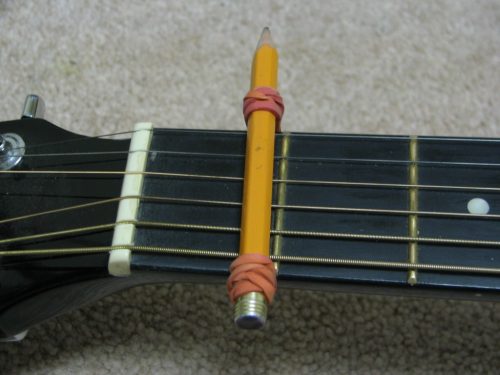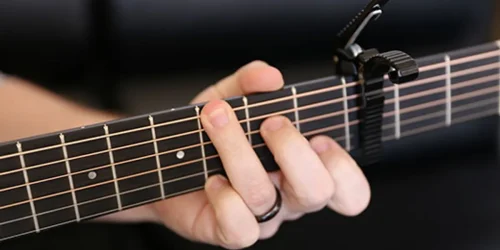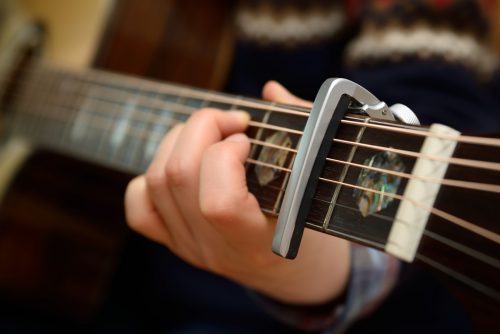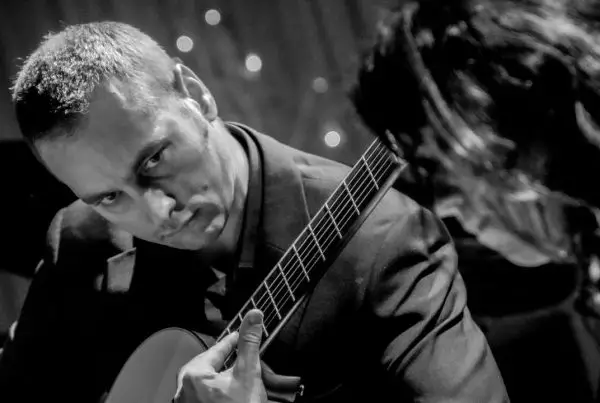To stop using a capo, the best is to learn how to transpose notes and chords appropriately or potentially change your tuning. Learning how to do so will help immensely as you progress in your guitar-playing skills.
Understanding the concept of keys can be a bit overwhelming when starting on the guitar. However, once you fully understand this, it will teach you music theory in more detail. Your musical ability will skyrocket once you get this down.
As someone who has played guitar for over fifteen years, I can confirm that a capo can add a whole new dimension to your guitar playing. Learning how to transpose songs into different keys will significantly help in understanding music theory.
This article will go over how a capo works and how you do not use a capo if you want to; in fact, stop using one. This article will also go over substitutes for a capo, whether or not beginners should use capos, and if it is really necessary to use a capo to play guitar.
How Does a Capo Work?
A capo works by pressing down on all the strings across one of the frets on your neck. This changes the key to the song that you are playing.
When you place the capo along the fret on your guitar’s fretboard, you are essentially changing the key in which you are playing your guitar. For additional information on where and how to place your capo on your guitar’s neck, please check out the video below:
How Do You Not Use a Capo?
1. Transpose the Chords
If you are not using a capo, you can transpose the chords to play your song in a different key.
Let us assume you are playing a song in the key of C that has three chords, C, F, and B, and that the song repeats this progression over and over again.
So, the hypothetical song you are playing has these three chords repeating over and over again and is in the key of C.
Let us also assume you want to transpose this song with the C, F, and B chord progression from the key of C into the key of G. To do so, start on the purple-colored column that says Key on top and look at the row that begins with C. We then go down to the row under the Key column that says G
If we are transposing the song to the key of G, we will play G for the C chord, C for the F chord, and F# for the B chord.
We determine this by looking at all of the chords in the row of the Key of C column, then go down to the Chord directly below each one in the G row; since this is the key, we are transposing the song to.
Please visit the link below for additional information regarding how to use this chart. Although the person in this video is playing the Ukulele, the same chord progression applies when transposing songs to and from different keys:
| Key | I | II | III | IV | V | VI | VII |
| C | C | Dm | Em | F | G | Am | B |
| G | G | Am | Bm | C | D | Em | F |
| D | D | Em | Fm | G | A | Bm | C |
| A | A | Bm | Cm | D | E | Fm | G |
| E | E | Fm | Gm | A | B | Cm | D |
| B | B | Cm | Dm | E | F | Gm | A |
| F | F | Gm | Am | B | C | Dm | E |
| C | C | Dm | Em | F | G | Am | B |
| F | F | Gm | Am | Bb | C | Dm | E |
| Bb | Bb | Cm | Dm | Eb | F | Gm | A |
| Eb | Eb | Fm | Gm | Ab | Bb | Cm | D |
| Ab | Ab | Bbm | Cm | Db | Eb | Fm | G |
| Db | Db | Ebm | Fm | Gb | Ab | Bbm | C |
| Gb | Gb | Abm | Bbm | Cb | Db | Ebm | F |
| Cb | Cb | Dbm | Ebm | Fb | Gb | Abm | Bb |
It can be entertaining and a great way to improve your understanding of musical theory to practice transposing your songs. However, there are some drawbacks.
The song may not sound ‘right’ in a different key, or if you are singing the song as you are playing, it can cause you to try to sing in an octave you may not be able to hit.
2. Tune down a half step or a whole step.
If you do not want the capo at all because you are trying to get your stings at a pitch lower than it already is with no capo at all, you can tune down a half step or a whole step.
A step is moving two frets up or down. A half step is moving one fret up or down. If the capo is on the second string, you will tune down two frets or a whole step. You will tune down half a step if the capo is on the first fret.
For example, if you are tuning down a half step (instead of placing the capo on the first fret), you would tune the guitar as follows:
- 6th string E flat
- 5th string A flat
- 4th string C sharp
- 3rd string F sharp
- 2nd string A sharp
- 1st string E flat
Also Read: Tuning Guitar With Capo: How To & Should You Do It?
Substitutes Of a Capo

A pencil with a rubber band is a great substitute for a capo
A pencil with a rubber band is a good substitute for a capo if you do not have one available.
To use this, take the pencil and place it across the fret. From there, wrap enough rubber bands around each end of the pencil and around the neck of the guitar (behind the fretboard) to create your capo.
A hairband is also a good substitute for a capo. You would use this in place of the pencil in the above example. Any other similarly shaped object to your index finger that would cover your fretboard can also work.
Should Beginners Use a Capo?

Using a Capo allows you to play more songs with fewer chords
If you are trying to form chords that, in the beginning, you have difficulty with, then a capo can be used to help you produce the sound you are looking for. However, I recommend against relying on capo all the time if you have been playing for a while.
I would discourage it because you will rapidly expand your knowledge of music theory (which will help immensely as you become a more experienced player) if you study the chord progression chart and learn which chords or notes to play to get the key you want. With a bit of practice and dedication, you will soon be able to do this in no time.
Do You Really Need a Capo for Guitar?

Not absolutely necessary, but it sure makes the guitarist’s life easier
You don’t need a capo for a guitar. However, it can help to play easily in different keys. It is also great to experiment with additional notes and sounds as you continue practicing.
Also Read: Where To Keep Guitar Capo When Not In Use: A Quick Guide
Conclusion
This article went over how a capo works and how you do not use a capo if you want to; in fact, stop using one. This article will also cover substitutes for a capo, whether or not beginners should use capos, and if it is really necessary to use a capo to play guitar.





